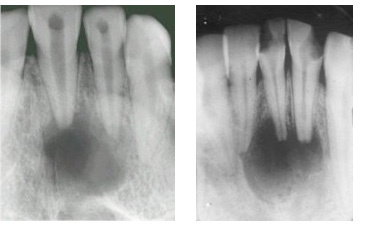Oral Surgery
DENTAL CYSTS
Cysts are “pockets of bacteria” that form at the tips of the roots of infected teeth.
Dental cysts can result in bacteria spreading throughout the body (septicaemia) or attacking the valves of the heart (infectious endocarditis), but they can also lead to infections in other organs, bones and joints.
Consequently, it is vital to remove dental cysts, which usually requires extracting the infected tooth, although some cysts can be removed while saving the tooth.
The procedure is generally carried out under local anaesthetic, but some cases may require general anaesthesia.
EXTRACTION OF IMPACTED TEETH
Wisdom teeth (or third molars) grow at the back of the gums and are the last teeth to come through, generally during adolescence/early adulthood (usually around the age of 17-18).
Changes in the human diet (softer food) combined with orthodontic treatment mean that there is not always enough space for wisdom teeth to grow properly. As a result, they push against the other teeth, which can cause a lot of pain and lead to the development of abscesses or to other teeth being displaced.
Consequently, it is usually recommended to remove wisdom teeth before they cause these problems.
In most cases, impacted wisdom teeth are removed under neuroleptanalgesia (NLA) in the Tonkin Clinic’s own operating theatre.
This procedure uses the same anaesthetic substances as general anaesthesia, but at lower doses, thereby reducing the hospitalisation period (1/2 day) and enabling patients to regain all their faculties more quickly.
In cases where the wisdom teeth have almost emerged, they can be extracted under local anaesthetic, with no need for hospitalisation.
Patients can usually go back to work or school the day after the operation.
Possible side effects of the operation include having swollen cheeks for a few days and the area from where the teeth were removed may be painful for up to a week, although analgesics (painkillers) alleviate this pain very effectively.


